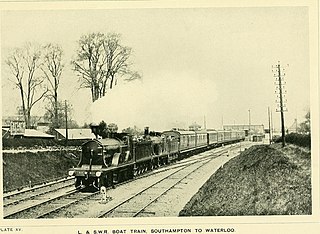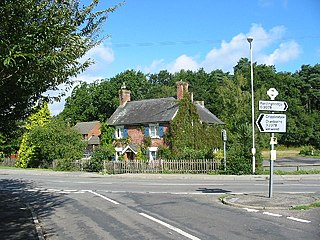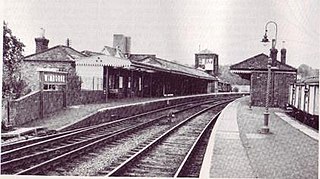
The London and South Western Railway was a railway company in England from 1838 to 1922. Starting as the London and Southampton Railway, its network extended from London to Plymouth via Salisbury and Exeter, with branches to Ilfracombe and Padstow and via Southampton to Bournemouth and Weymouth. It also had many routes connecting towns in Hampshire and Berkshire, including Portsmouth and Reading. In the grouping of railways in 1923 the LSWR amalgamated with other railways to create the Southern Railway.

Fordingbridge is a town and broader civil parish with a population of 6,000 on the River Avon in the New Forest District of Hampshire, England, near to the Dorset and Wiltshire borders and on the edge of the New Forest, with museum and a late medieval 7-arch bridge. It is 81 miles (130 km) southwest of London, and 10 miles (16 km) south of the city of Salisbury. Fordingbridge is a former market town. The Avon Valley Path passes through the town. The town excluding linear settlement Sandleheath has a density of 30.2 persons per hectare.

Alderholt is a large village and civil parish in east Dorset, England; situated 3 miles (4.8 km) west of Fordingbridge. The parish includes the hamlets of Crendell and Cripplestyle. The local travel links are located 11 miles (18 km) from the village to Salisbury railway station and 9 miles (14 km) to Bournemouth International Airport. The main road running through the village is the B3078 connecting Alderholt to Fordingbridge and Shaftesbury. The village has a population of 3,113 according to the 2001 Census, increasing along with the electoral ward of the same name to 3,171 at the 2011 Census.

Newton Abbot railway station serves the town of Newton Abbot in Devon, England. It is 20 miles 13 chains (32.4 km) down the line from Exeter St Davids and 214 miles 5 chains (344.5 km) measured from London Paddington via Bristol Temple Meads, at the junction for the branch to Paignton. The station today is managed by Great Western Railway, who provide the train service along with CrossCountry.

Hove railway station serves Hove in the county of East Sussex, England. It is 50 miles 56 chains (81.6 km) measured from London Victoria. The station and the majority of trains serving it are operated by Southern.

Romsey railway station serves the town of Romsey in Hampshire, England. It is on the Wessex Main Line and is at the junction for the Eastleigh to Romsey Line. It is 80 miles 47 chains (129.7 km) measured from London Waterloo.

Southampton Airport Parkway railway station is on the South Western main line located in the south of Eastleigh in Hampshire, England, 74 miles 66 chains (120.4 km) down the line from London Waterloo. It is adjacent to Southampton Airport.

Plymouth Millbay railway station was the original railway terminus in Plymouth, Devon, England. It was used for passenger trains from 1849 to 1941. It was rebuilt in 1903.

The A338 is a major primary route in southern England, that runs from the junction with the A35 at Poole in Dorset to the junction with the A420 at Besselsleigh in Oxfordshire, a distance of 84 miles (135 km).

Exmouth Junction is the railway junction where the Exmouth branch line diverges from the London Waterloo to Exeter main line in Exeter, Devon, England. It was for many years the location for one of the largest engine sheds in the former London and South Western Railway. The sidings served the railway's concrete casting factory as well as a goods yard.

Daggons Road was a railway station serving the village of Alderholt, in Dorset, to the south west of Fordingbridge, in Hampshire. It was one of many casualties of the mass closure of British railway lines in the 1960s and 1970s; the last service was on 2 May 1964. It was on the Salisbury and Dorset Junction Railway, which ran north–south along the River Avon just to the West of the New Forest, connecting Salisbury to the North and Poole to the south.

There are eleven disused railway stations between Exeter St Davids and Plymouth Millbay, Devon, England. At eight of these there are visible remains. Of the eleven stations, South Brent and Plympton are subject of campaigns for reopening while Ivybridge station was replaced by another station on a different site.
There are seventeen disused railway stations on the Cornish Main Line between Plymouth in Devon and Penzance in Cornwall, England. The remains of nine of these can be seen from passing trains. While a number of these were closed following the so-called "Beeching Axe" in the 1960s, many of them had been closed much earlier, the traffic for which they had been built failing to materialise.

Verwood Railway Station served the town of Verwood, Dorset, and its hinterland, from 1866 to 1964. It was one of many casualties of the mass closure of British railway lines in the 1960s; the last train running on 2 May 1964. The village is now much larger than when the line ran as it is within reasonable travelling distance of the South East Dorset conurbation.
The Salisbury and Dorset Junction Railway was a railway that ran in the English counties of Wiltshire, Hampshire and Dorset from 1866 until its closure in 1964. Working from Salisbury, trains left the Salisbury to Southampton line at the remote Alderbury Junction. Here there was a signal box, some railway cottages and two platforms on the main line for staff use only. The line ambled south through rural surroundings to meet the Southampton and Dorchester Railway at West Moors. Trains continued through Wimborne to Poole and Bournemouth West.

Wimborne was a railway station in Wimborne Minster in the county of Dorset in England. Open from 1 June 1847 to 2 May 1977, it was sited just north of the River Stour in what is still Station Road. Built for the Southampton and Dorchester Railway, the station was operated from the start by the London and South Western Railway, which took over ownership in 1848. It was then operated by the Southern Railway (1923–47) and from 1948 by the Southern Region of British Railways which traded as British Rail from 1965.

Devonport Kings Road railway station was the London and South Western Railway station in Devonport, Devon, England. It opened in 1876 and closed in 1964. For the first 14 years it was a terminal station with trains to London departing eastwards, but from 1890 it became a through station with trains to London departing westwards.
Newtown Halt was a railway station on the Midland and Great Northern Joint Railway (M&GN) which served the northern part of Great Yarmouth in Norfolk, England. Opened in 1933, it was closed as a wartime economy measure and reopened in 1948 only to last a further eleven years before closing with the line.

The Chard branch lines were two lines serving the town of Chard in Somerset, England. One was a northward branch, opened in 1863, from the Salisbury to Exeter main line, and the other, opened in 1866, ran south-eastwards from the Bristol – Taunton main line. Each branch had its own Chard passenger station at first, although the two lines connected in Chard.
The Yeovil–Taunton line was a railway line in England, built by the Bristol and Exeter Railway (B&ER) to connect its main line with the market town of Yeovil in Somerset. It opened in 1853 using the broad gauge of 7 ft 1⁄4 in and was the first railway to serve Yeovil. It ran from a junction at Durston although in later years passenger trains on the line ran through to and from Taunton where better main and branch line connections could be made.
















